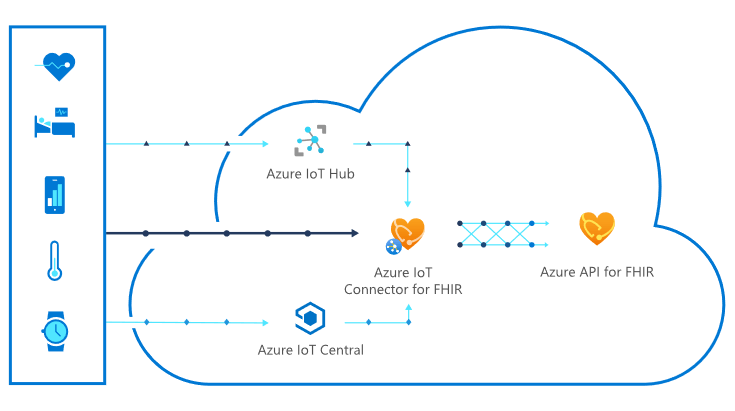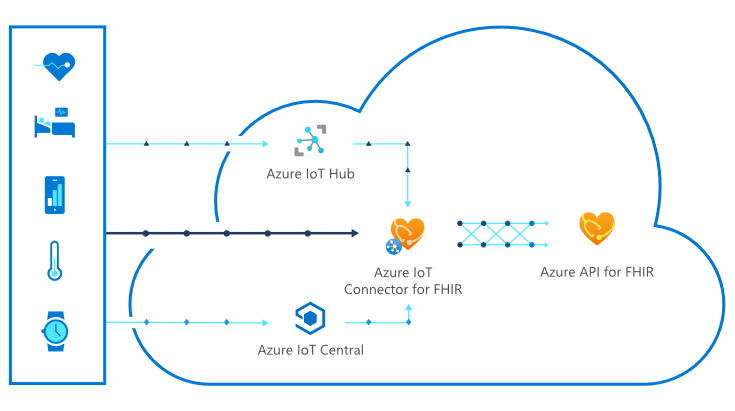

What You Should Know:
– Microsoft released the public preview of Azure IoT
Connector for FHIR (Fast Healthcare Interoperability Resources), the latest
update to the Microsoft Cloud for Healthcare.
– The Azure IoT Connector for FHIR makes it easy for
health developers to set up a pipeline to manage protected health information
(PHI) from IoT devices and enable care teams to view patient data in context
with clinical records in FHIR.
This week, Microsoft released the preview of Azure
IoT Connector for FHIR—a fully managed feature of the Azure API for FHIR.
The connector empowers health teams with the technology for a scalable
end-to-end pipeline to ingest, transform, and manage Protected Health
Information (PHI) data from devices using the security of FHIR APIs.
Telehealth
and remote monitoring. It’s long been talked about in the delivery of
healthcare, and while some areas of health have created targeted use cases in
the last few years, the availability of scalable telehealth platforms that can
span multiple devices and schemas has been a barrier. Yet in a matter of
months, COVID-19 has accelerated the discussion. There is an urgent need for
care teams to find secure and scalable ways to deliver remote monitoring
platforms and to extend their services to patients in the home environment.
Unlike other services that can use generic video services
and data transfer in virtual settings, telehealth visits and remote monitoring
in healthcare require data pipelines that can securely manage Protected Health
Information (PHI). To be truly effective, they must also be designed for
interoperability with existing health software like electronic medical record
platforms. When it comes to remote monitoring scenarios, privacy, security, and
trusted data exchanges are must-haves. Microsoft is actively investing in
FHIR-based health technology like the Azure IoT Connector for FHIR to ensure
health customers have an ecosystem they trust.
Azure IoT Connector for FHIR Key Features
With the Azure IoT Connector for FHIR available as a feature
on Microsoft’s cloud-based FHIR service, it’s now quick and easy for health
developers to set up an ingestion pipeline, designed for security to manage PHI
from IoT devices. The Azure IoT Connector for FHIR focuses on biometric data at
the ingestion layer, which means it can connect at the device-to-cloud or cloud-to-cloud
workstreams. Health data can be sent to Event Hub, Azure IoT Hub, or Azure IoT
Central, and is converted to FHIR resources, which enables care teams to view
patient data captured from IoT devices in context with clinical records in
FHIR.
Key features of the Azure IoT Connector for FHIR include:
– Conversion of biometric data (such as blood glucose, heart
rate, or pulse ox) from connected devices into FHIR resources.
– Scalability and real-time data processing.
– Seamless integration with Azure IoT solutions and Azure
Stream Analytics.
– Role-based Access Control (RBAC) allows for managing
access to device data at scale in Azure API for FHIR.
– Audit log tracking for data flow.
– Helps with compliance in the cloud: ISO 27001:2013 certified supports HIPAA and GDPR, and built on the HITRUST certified Azure platform.
Microsoft customers are already ushering in the next generation of healthcare
Some of the healthcare organizations who are embracing the technology include:
– Humana will accelerate remote monitoring programs for
patients living with chronic conditions at its senior-focused primary care
subsidiary, Conviva Care Centers.
– Sensoria is enabling secure data exchange from its Motus
Smart remote patient monitoring device, allowing clinicians to see real-time
data and proactively reach out to patients to manage care.
– Centene is managing personal biometric data and will
explore near-real-time monitoring and alerting as part of its overall priority
on improving the health of its members.